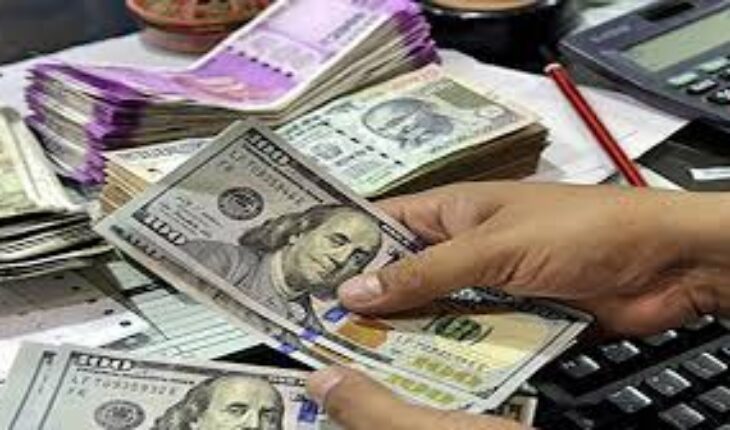The fall in the exchange rate of rupee against the dollar is a major obstacle in the path of development. It is necessary to overcome this to ensure smooth development. The Reserve Bank of India is using foreign exchange reserves to prevent the fall in the exchange rate. Since the dollar is the most powerful currency in the world, it is largely through it that trades are conducted across the world.
The rupee witnessed its biggest fall in 2 years during day trading on 27 December 2024 and became one of the worst performing currencies in Asia. The rupee has consistently closed at a weak level at the end of the calendar year against the dollar in the last 7 years. The rupee has fallen by 2.7 percent so far in the year 2024. The rupee weakened to a low of 85.82 and has now come down to 85.54 per dollar, which is the lowest level of the rupee so far. Again, this is the biggest fall in the exchange rate of rupee against the dollar since the global recession of 2008.
Due to the use of foreign exchange reserves to reduce the weakness of the rupee, a decrease of $ 8.48 billion was recorded in the foreign exchange reserves on 27 December 2024. Last week, on 20 December, $ 1.99 billion was withdrawn from the foreign exchange reserves. In the month of September, the foreign exchange reserves had increased to the level of $ 704.88 billion. Since then, it has been continuously declining and now it has reached the level of $ 644.87 billion.
Right now, the level of foreign exchange reserves cannot be considered worrisome, but if the foreign exchange reserves keep decreasing like this, it will not be good for the health of the economy. Decrease in foreign exchange reserves means that investors are not investing in India, which cannot be considered a good sign at all. Usually, as soon as the dollar strengthens, foreign investors turn to the US market in the hope of higher returns and when it weakens, investors again turn to the markets of other countries in the hope of higher returns.
There are some other important reasons for the fall in the value of rupee against the dollar in India, such as, India’s trade deficit is constantly increasing. This usually happens due to reduced exports and more imports. Since, India still does not produce all the goods needed and is completely or partially dependent on the import of many products.
Most of the transactions in the international market are done through the US dollar. Therefore, dollars are needed for imports, which directly affects the market and the production of various goods. For example, if an industry is dependent on raw material for production which is not found in India or if an essential product is not available in India, then it is imported to meet the need of the people.
After coming to power, the positive & convincing speeches of the US President have increased the confidence of investors in the US market, due to which the dollar has strengthened. Now foreign investors have started investing in US by withdrawing their investments in other countries. Meanwhile, the US Federal Reserve recently hinted at bringing changes in its benchmark interest rate and said that it can cut interest rates twice in 2025. After this announcement, the dollar index reached 108.086, which is the highest level in the last two years. This has also increased the confidence of investors in the dollar.
The fall in the rupee has a direct impact on the cost of imported goods, which includes the raw material or parts for the manufacture of a product in addition to the imported product. For example, if someone had to spend Rs 8300 earlier to buy a product worth $100, then after the rupee weakened, he or she would have to spend Rs 8,500. Obviously, this will affect both the budget and investment of the common man.
The dollar becoming expensive has a direct impact on the price of crude oil. Since India does not produce enough fuel to fulfil its requirement, it is dependent on imports to ensure the availability of crude oil. Therefore, when the cost of crude oil increases, the cost of transportation increases, which increases the price of essential items, especially food products, which spoils everyone’s household budget.
The cost of those who go abroad for the purpose of studies or tourism also increases due to the weakening of the rupee. The cost of products of businesses that are dependent on imports also increases and the profitability of the company decreases. However, exporters will benefit from the weakening of the rupee. For example, businesses in sectors like IT, pharma, and gems and jewellery will benefit because their businesses export and they get higher prices for their products due to the strengthening of the dollar.
The weakening of the rupee also has a negative impact on the stock market because foreign investors invest in the US dollar instead of the rupee in the hope of higher returns and for this, they withdraw their investments from the Indian market. Investors who have invested in the US stock market benefit. In this context, to avoid the ill effects of the weakening of the rupee, investors can reduce their losses to some extent by changing their portfolio.
For the past few quarters, the performance of the manufacturing sector in our country has been poor and a decline has been recorded in industrial production. Due to inflation, consumer expenditure has decreased, as it has reduced the purchasing power of the people. This is also likely to have a negative impact on the Gross Domestic Product (GDP). In such a situation, the weakness of the rupee is making the situation even more serious.
It can be said that the benefits of weakening of the rupee are less and the disadvantages are more. Therefore, to take corrective measures in the matter, the Reserve Bank of India will have to make efforts to increase the foreign exchange reserves, which is certainly a challenging task, as India is still dependent on imports to meet many of its needs. At present, the possibility of increasing political and economic instability at the international level cannot be ruled out. There is also a possibility of the Federal Reserve cutting interest rates in the coming months. In such a situation, it is being speculated that by the end of the last quarter of the current financial year, the exchange rate of rupee against the dollar may reach the level of Rs 86 per dollar.
Satish Singh, Ahmedabad Based Senior Columnist, views are personal






